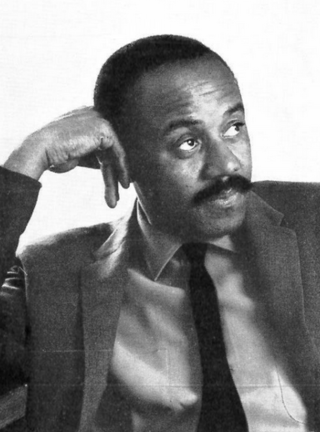Life and career
Joseph Holston grew up in the small Black community of Hawkins Lane, in what was then a rural area of Chevy Chase, Maryland, in suburban Washington, D.C. His work reflects the strong sense of Black identity nurtured by his upbringing in that close-knit community. In 1960 the family moved to Washington, DC, where Holston was accepted into the commercial art program at Chamberlain Vocational High School.
Holston worked as a commercial artist/illustrator from 1964 to 1970. He also pursued independent study by enrolling in art classes throughout the Washington, DC area. These included classes with the noted portraitist Marcos Blahove (1928-2012). [1] [2] In the summer of 1971 Holston traveled to Santa Fe, New Mexico to study with artist, Richard Vernon Goetz (1915-1991), a well-known portrait, landscape, and still-life painter. [3] [4] Within months of returning to Washington, DC, Holston resigned from his job as a commercial artist, to begin painting full-time. The following year his painting Ghetto Boy was purchased by Texas businessman and former Postmaster General W. Marvin Watson Jr., and gifted to the collection of the Lyndon Baines Johnson Library and Museum. [5]
Inspired by Rembrandt's prints, Holston began creating etchings in 1974. "For Joseph Holston--in every way the embodiment of the contemporary painter-engraver--etching is as integral to his creative output as is painting." [6] Holston incorporates an array of visual effects in his etchings, through the use of hard ground, soft ground and aquatint, as in Woman with Pipe (1974), one of his first prints, now included in the permanent collection of The Phillips Collection in Washington, D. C. Other prints are included in the collection of the Smithsonian American Art Museum, among other museum collections.

His first solo museum exhibition was at the Butler Institute of American Art, in Youngstown, Ohio, in 1975. The following year, during a three-month stay in Tanzania, Holston painted and taught workshops at the University of Dar es Salaam. [7] Holston's body of work beginning from that period reflects a gradual transition from the purely narrative and realistic to stronger statements using "bold color, expressive forms, and rhythmic lines". [8] His artistic progression also included collage works. From 1979 to 1990, Holston expanded his knowledge of printmaking, creating etching-collagraphs, as well as screen prints. After 1990, he continued to print his own etchings, and also began working with a master screen printer. A retrospective exhibition of his printmaking, Limited Editions: Joseph Holston Prints, 1974 - 2010 was exhibited at the University of Maryland's David C. Driskell Center, [9] and at the African American Museum in Philadelphia. In 2020, Holston's oil painting The Elder, and his etching Charity were included in The Phillips Collection's centennial exhibition ″Seeing Differently: The Phillips Collects for a New Century.″
Other major solo exhibitions were at the Washington County Museum of Fine Arts, the Southern Alleghenies Museum of Art, [10] the Reginald F. Lewis Museum of Maryland African American History and Culture, and the Federal Reserve Arts Program in Washington, D. C. He has been Artist-in-Residence at the University of Maryland Eastern Shore, North Carolina A & T State University, and the Experimental Printmaking Institute at Lafayette College. [11]










